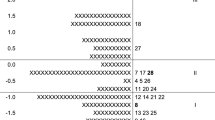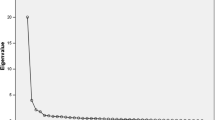Abstract
The continued call for twenty-first century skills renders computational thinking a topical subject of study, as it is increasingly recognized as a fundamental competency for the contemporary world. Yet its relationship to academic performance is poorly understood. In this paper, we explore the association between computational thinking and academic performance. We test a structural model—employing a partial least squares approach—to assess the relationship between computational thinking skills and academic performance. Surprisingly, we find no association between computational thinking skills and academic performance (except for a link between cooperativity and academic performance). These results are discussed respecting curricular mandated instruction in higher-order thinking skills and the importance of curricular alignment between instructional objectives and evaluation approaches for successfully teaching and learning twenty-first-century skills.

Similar content being viewed by others
References
Anderson, L. (2002). Curricular alignment: A re-examination. Theory into Practice, 41(4), 255–264.
Ater-Kranov, A., Bryant, R., Orr, G., Wallace, S., & Zhang, M. (2010). Developing a community definition and teaching modules for computational thinking: Accomplishments and challenges. In Proceedings of the 2010 ACM conference on information technology education (pp. 143–148). ACM.
Atmatzidou, S., & Demetriadis, S. (2016). Advancing students’ computational thinking skills through educational robotics: A study on age and gender relevant differences. Robotics And Autonomous Systems, 75, 661–670. doi:10.1016/j.robot.2015.10.008.
Barr, V., & Stephenson, C. (2011). Bringing computational thinking to K-12. ACM Inroads, 2(1), 48. doi:10.1145/1929887.1929905.
Bateman, D., Taylor, S., Janik, E., & Logan, A. (2008). Curriculum coherence and student success. Champlain College CEGEP. Retrieved from: http://www.cdc.qc.ca/parea/786950_bateman_curriculums_champlain_st_lambert_PAREA_2007.pdf.
Bazelais, P., Lemay, D. J., & Doleck, T. (2016). How does grit impact college students’ academic achievement in science? European Journal of Science and Mathematics Education, 4(1), 33–43.
Biggs, J. (1996). Enhancing teaching through constructive alignment. Higher Education, 32, 1–18.
Biggs, J. (1999). Teaching for quality learning at university. Society for Research into Higher Education/Open University Press.
Brennan, K., & Resnick, M. (2012). New frameworks for studying and assessing the development of computational thinking. Vancouver: Paper presented at the American Educational Research Association.
Bundy, A. (2007). Computational thinking is pervasive. Journal of Scientific and Practical Computing, 1(2), 67–69.
Cooper, S., Pérez, L., & Rainey, D. (2010). K-12 computational learning. Communications of the ACM, 53(11), 27. doi:10.1145/1839676.1839686.
Denning, P. (2009). The profession of IT beyond computational thinking. Communications of the ACM, 52(6), 28. doi:10.1145/1516046.1516054.
Deschryver, M. D., & Yadav, A. (2015). Creative and computational thinking in the context of new literacies: Working with teachers to scaffold complex technology-mediated approaches to teaching and learning. Journal of Technology and Teacher Education, 23(3), 411–431.
Farris, A. V., & Sengupta, P. (2014). Perspectival computational thinking for learning physics: A case study of collaborative agent-based modeling. In Proceedings of the 12th international conference of the learning sciences (ICLS 2014) (pp. 1102–1107).
Fornell, C., & Larcker, D. (1981). Evaluating structural equation models with unobservable variables and measurement error. Journal of Marketing Research, 18(1), 39–50.
Foundation for Critical Thinking. (2015). Elements and standards learning tool. Retrieved from: http://www.criticalthinking.org/pages/analyzing-and-assessing-thinking-/783.
Futschek, G. (2006). Algorithmic thinking: The key for understanding computer science. In International conference on informatics in secondary schools-evolution and perspectives (pp. 159–168). Berlin: Springer.
Google for Education. (n.d.). CT overview. Retrieved from https://edu.google.com/resources/programs/exploring-computational-thinking/#!ct-overview.
Gretter, S., & Yadav, A. (2016). Computational thinking and media & information literacy: An integrated approach to teaching twenty-first century skills. Techtrends, 60(5), 510–516. doi:10.1007/s11528-016-0098-4.
Grover, S., & Pea, R. (2013). Computational thinking in K-12: A review of the state of the field. Educational Researcher, 42(1), 38–43. doi:10.3102/0013189x12463051.
Guzdial, M. (2008). Education paving the way for computational thinking. Communications of the ACM, 51(8), 25. doi:10.1145/1378704.1378713.
Hair, J., Ringle, C., & Sarstedt, M. (2011). PLS-SEM: Indeed a silver bullet. The Journal of Marketing Theory and Practice, 19(2), 139–152. doi:10.2753/mtp1069-6679190202.
Hu, C. (2011). Computational thinking: What it might mean and what we might do about it. In Proceedings of the 16th annual joint conference on innovation and technology in computer science education (pp. 223–227). ACM.
Katai, Z. (2014). The challenge of promoting algorithmic thinking of both sciences- and humanities-oriented learners. Journal of Computer Assisted Learning, 31(4), 287–299. doi:10.1111/jcal.12070.
Kiss, G., & Arki, Z. (2017). The influence of game-based programming education on the algorithmic thinking. Procedia - Social and Behavioral Sciences, 237(21), 613–617.
Kock, N. (2015a). WarpPLS. Retrieved from http://www.warppls.com.
Kock, N. (2015b). WarpPLS 5.0 user manual. ScripWarp Systems. Retrieved from http://cits.tamiu.edu/WarpPLS/UserManual_v_5_0.pdf.
Korkmaz, Ö., Çakir, R., & Özden, M. (2017). A validity and reliability study of the computational thinking scales (CTS). Computers in Human Behavior. doi:10.1016/j.chb.2017.01.005.
Kules, B. (2016). Computational thinking is critical thinking: Connecting to university discourse, goals, and learning outcomes. In Proceedings of the association for information science and technology. Silver Springs, MD: American Society for Information Science.
Lee, I., Martin, F., & Apone, K. (2014). Integrating computational thinking across the K-8 curriculum. ACM Inroads, 5(4), 64–71. doi:10.1145/2684721.2684736.
Liu, J., & Wang, L. (2010). Computational thinking in discrete mathematics. In IEEE 2nd international workshop on education technology and computer science (pp. 413–416).
Lockwood, J., & Mooney, A. (2017). Computational thinking in education: Where does it fit? A Systematic Literary Review. (under review).
Lu, J., & Fletcher, G. (2009). Thinking about computational thinking. ACM SIGCSE Bulletin, 41(1), 260–264. doi:10.1145/1539024.1508959.
Lye, S., & Koh, J. (2014). Review on teaching and learning of computational thinking through programming: What is next for K-12? Computers in Human Behavior, 41, 51–61. doi:10.1016/j.chb.2014.09.012.
Mezirow, J. (2000). Learning as transformation: Critical perspectives on a theory in progress. San Francisco: Jossey-Bass.
Mishra, P., Yadav, A., & Deep-Play Research Group. (2013). Rethinking technology & creativity in the 21st century. TechTrends, 57(3), 10–14.
Mueller, J., Beckett, D., Hennessey, E., & Shodiev, H. (2017). Assessing computational thinking across the curriculum. In Emerging research, practice, and policy on computational thinking (pp. 251–267). Springer International Publishing.
National Council for Curriculum and Assessment. (2013). Draft specification for junior cycle short course. Retrieved from http://www.juniorcycle.ie/NCCA_JuniorCycle/media/NCCA/Documents/Consultation/Short%20Courses/SC_P_and_C.pdf.
National Research Council. (2011). Report of a workshop of pedagogical aspects of computational thinking. Retrieved from http://www.nap.edu/catalog.php?record_id=13170.
Papert, S. (1996). An exploration in the space of mathematics educations. International Journal of Computers for Mathematical Learning, 1(1), 95–123. doi:10.1007/bf00191473.
Polya, G. (1981). Mathematical discovery: On understanding, learning and teaching problem solving. New York: Wiley.
Resnick, M., Silverman, B., Kafai, Y., Maloney, J., Monroy-Hernández, A., Rusk, N., et al. (2009). Scratch. Communications of the ACM, 52(11), 60. doi:10.1145/1592761.1592779.
Román-González, M., Pérez-González, J., & Jiménez-Fernández, C. (2017). Which cognitive abilities underlie computational thinking? Criterion validity of the computational thinking test. Computers in Human Behavior, 72, 678–691. doi:10.1016/j.chb.2016.08.047.
Sawyer, K. (2012). Explaining creativity: The science of human innovation (2nd ed.). New York: Oxford Univ. Press.
Sengupta, P., Kinnebrew, J., Basu, S., Biswas, G., & Clark, D. (2013). Integrating computational thinking with K-12 science education using agent-based computation: A theoretical framework. Education And Information Technologies, 18(2), 351–380. doi:10.1007/s10639-012-9240-x.
Snalune, P. (2015). The benefits of computational thinking. ITNOW, 57(4), 58–59. doi:10.1093/itnow/bwv111.
Standl, B. (2016). A case study on cooperative problem solving processes in small 9th grade student groups. IEEE global engineering education conference (EDUCON), Abu Dhabi (pp. 961–967).
Voogt, J., Fisser, P., Good, J., Mishra, P., & Yadav, A. (2015). Computational thinking in compulsory education: Towards an agenda for research and practice. Education and Information Technologies, 20(4), 715–728. doi:10.1007/s10639-015-9412-6.
Voskoglou, M. G., & Buckley, S. (2012). Problem solving and computers in a learning environment. Egyptian Computer Science Journal, 36(4), 28–46.
Warneken, F., Steinwender, J., Hamann, K., & Tomasello, M. (2014). Young children’s planning in a collaborative problem-solving task. Cognitive Development, 31, 48–58. doi:10.1016/j.cogdev.2014.02.003.
Weintrop, D., Beheshti, E., Horn, M., Orton, K., Jona, K., Trouille, L., et al. (2015). Defining computational thinking for mathematics and science classrooms. Journal of Science Education and Technology, 25(1), 127–147. doi:10.1007/s10956-015-9581-5.
Wenger, E. (1998). Communities of practice: Learning, meaning, and identity. Cambridge: Cambridge University Press.
Williams, R. L. (2005). Targeting critical thinking within teacher education: The potential impact on Society. The Teacher Educator, 40(3), 163–187.
Wing, J. (2006). Computational thinking. Communications of the ACM, 49(3), 33. doi:10.1145/1118178.1118215.
Wing, J. (2008). Computational thinking and thinking about computing. Philosophical Transactions Of The Royal Society A: Mathematical, Physical And Engineering Sciences, 366(1881), 3717–3725. doi:10.1098/rsta.2008.0118.
Wing, J. (2011). Research notebook: Computational thinking—What and why? The Link Newsletter, 6, 1–32. Retrieved from http://link.cs.cmu.edu/files/11-399_The_Link_Newsletter-3.pdf.
Wing, J. (2014). Computational thinking benefits society. Social issues in computing. Retrieved from http://socialissues.cs.toronto.edu/2014/01/computational-thinking/.
Wold, H. (1982). Soft modeling: The basic design and some extensions. In K. Joreskog & H. Wold (Eds.), Systems under indirect observation (pp. 1–54). Amsterdam: North-Holland.
Yadav, A., Hong, H., & Stephenson, C. (2016). Computational thinking for all: Pedagogical approaches to embedding 21st century problem solving in K-12 classrooms. Techtrends, 60(6), 565–568. doi:10.1007/s11528-016-0087-7.
Yadav, A., Stephenson, C., & Hong, H. (2017). Computational thinking for teacher education. Communications of the ACM, 60(4), 55–62. doi:10.1145/2994591.
Author information
Authors and Affiliations
Corresponding author
Rights and permissions
About this article
Cite this article
Doleck, T., Bazelais, P., Lemay, D.J. et al. Algorithmic thinking, cooperativity, creativity, critical thinking, and problem solving: exploring the relationship between computational thinking skills and academic performance. J. Comput. Educ. 4, 355–369 (2017). https://doi.org/10.1007/s40692-017-0090-9
Received:
Revised:
Accepted:
Published:
Issue Date:
DOI: https://doi.org/10.1007/s40692-017-0090-9




